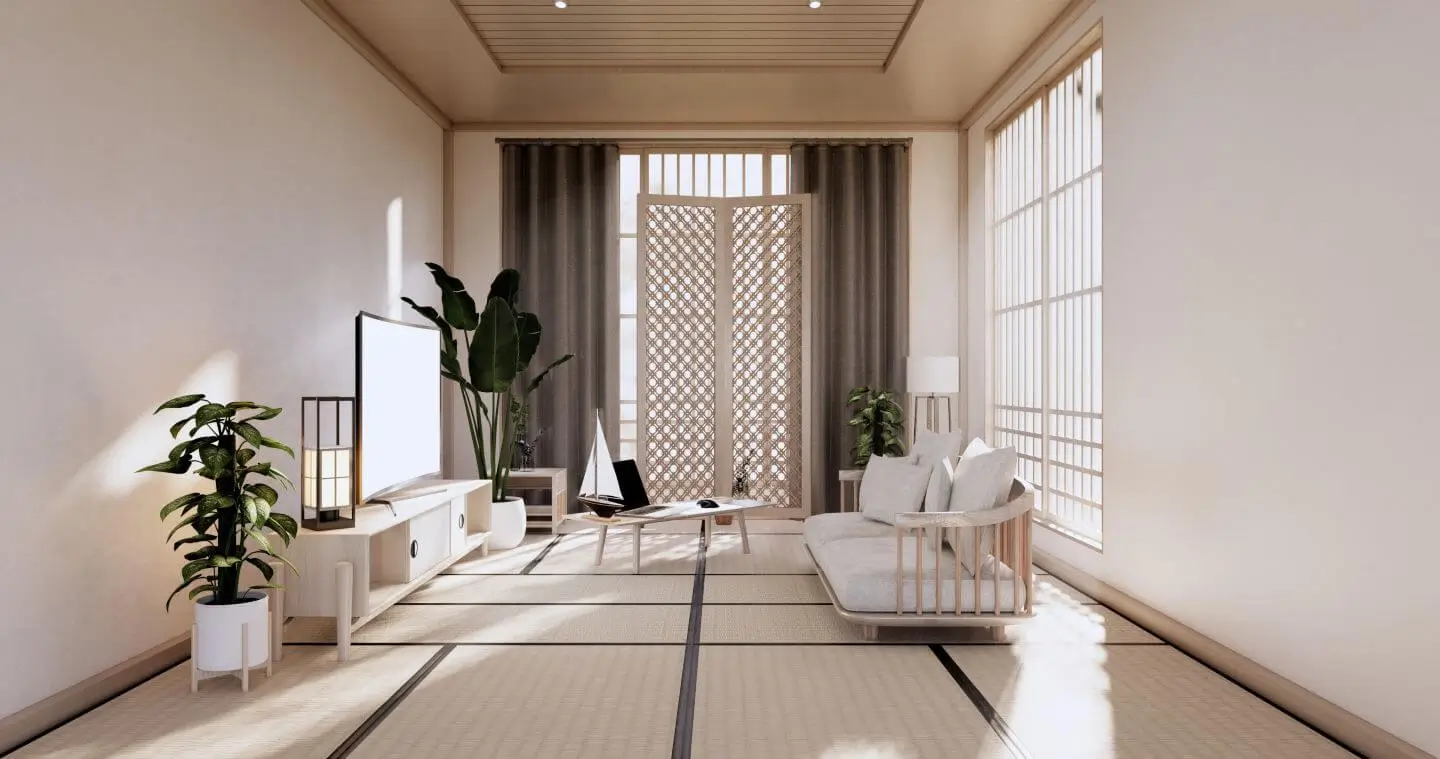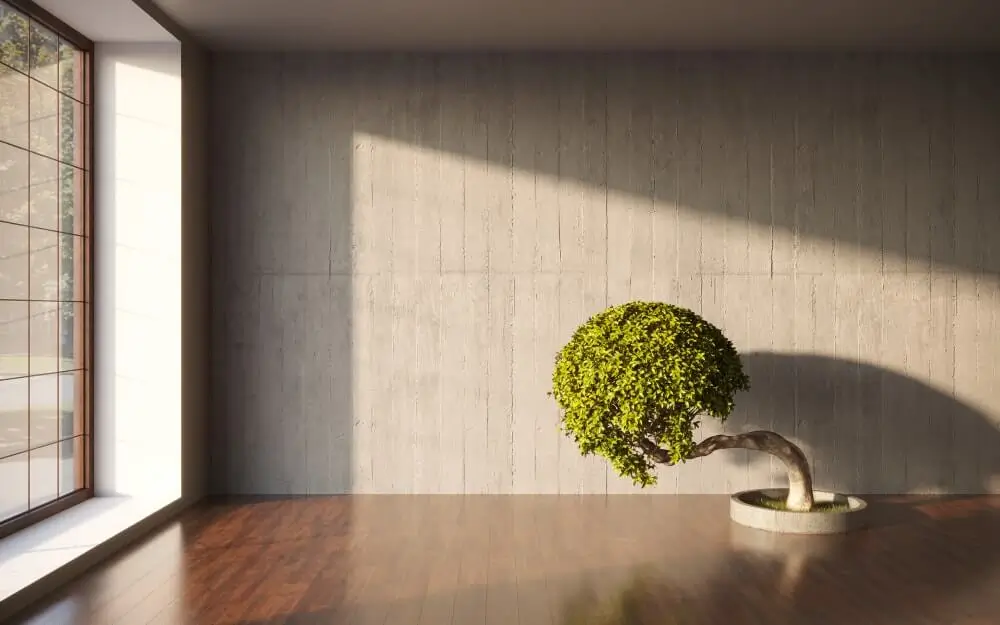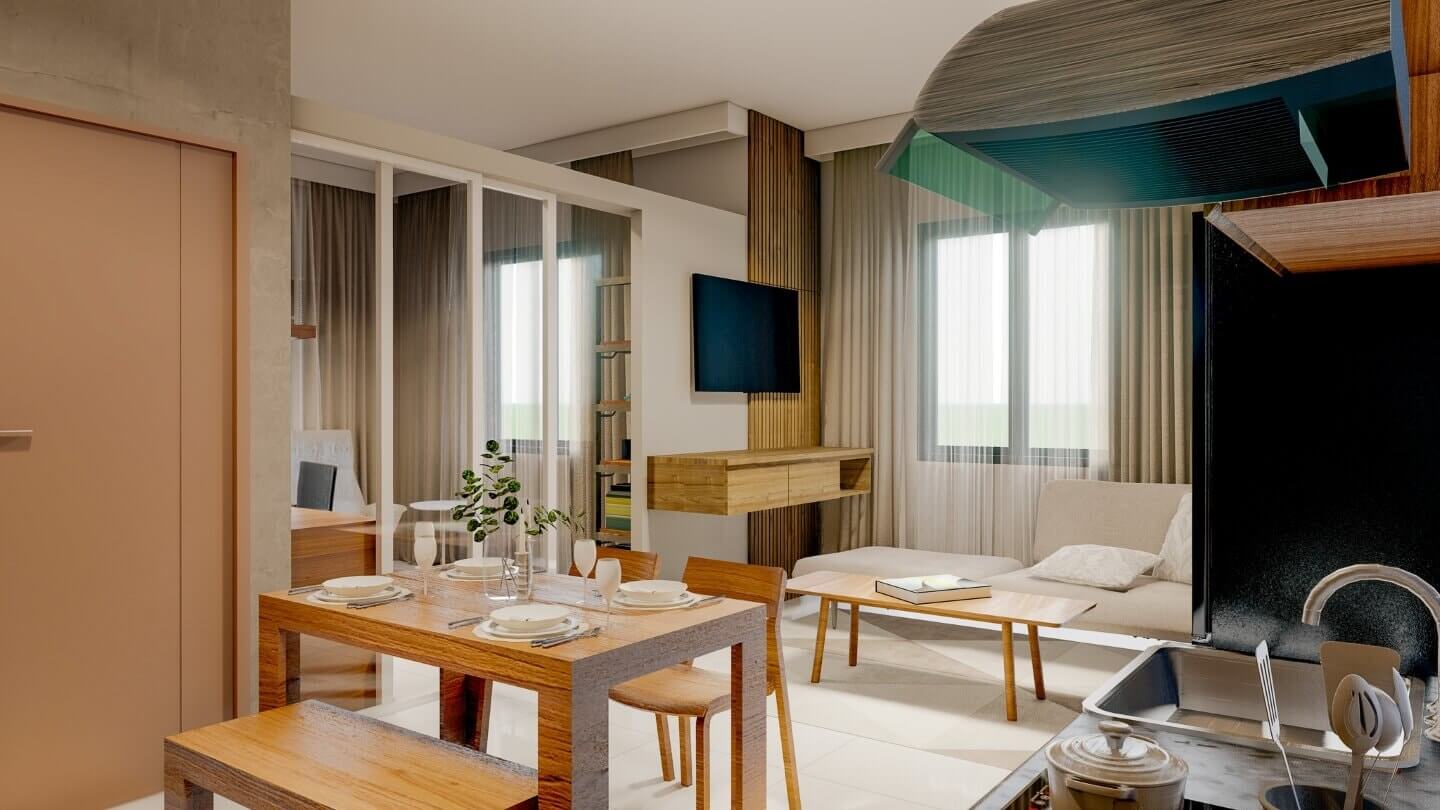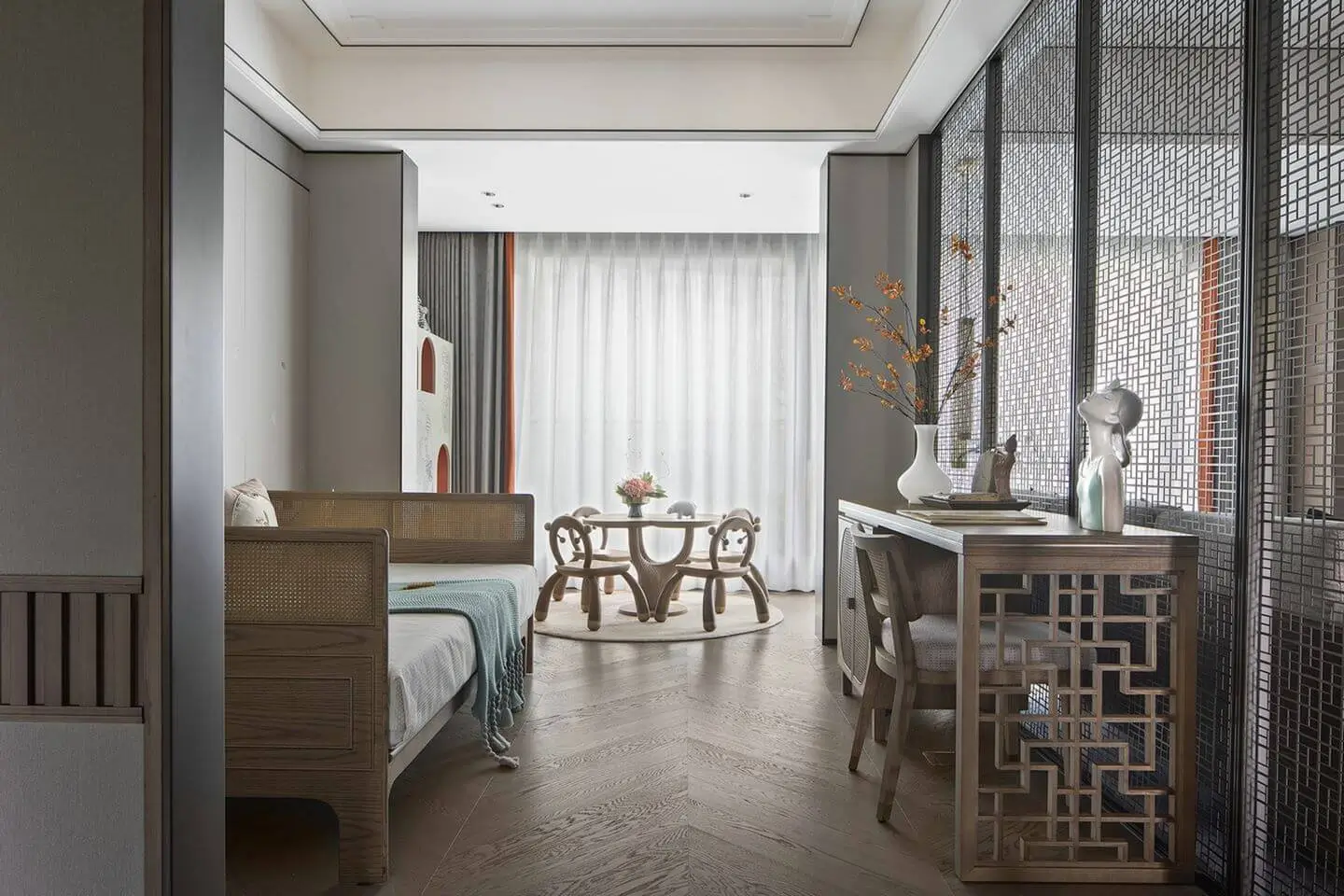In today’s fast-paced world, many homeowners are turning to the calm and simplicity of the minimalist Japanese condo aesthetic, a design philosophy rooted in Japanese style interior design and inspired by the timeless elegance of traditional Japanese homes.
Known for its use of natural materials, an abundance of natural light, and the integration of natural elements that reflect the natural world, this style fosters a serene atmosphere and a grounded sense of living.
At the heart of this approach is the thoughtful use of negative space, a signature of Japanese interior design that highlights both restraint and functionality. Emphasizing minimalist aesthetic principles, this style promotes clarity through uncluttered layouts, sliding doors for flexible living, and multi-functional furniture that maximizes every inch of your condo space.
Designing a condo unit with this aesthetic in mind means selecting minimalist furniture, like a low-profile coffee table or a simple dining table crafted from natural wood, and ensuring seamless transitions between rooms to create a seamless flow in your living space.
Incorporating built-in storage keeps clutter at bay, while large windows and other natural light sources brighten the home and draw attention to its natural beauty.
Whether you’re redecorating a small unit or starting fresh in a new space, the essence of interior design grounded in Japanese interiors can help you achieve a tranquil, harmonious, and purposefully designed home. Let’s explore the essential elements that bring this natural aesthetic to life.
Design Philosophy of Japanese Interiors
At the heart of Japanese interior design lies the concept of Ma, the intentional use of empty space to create balance, clarity, and calm. This foundational design philosophy, drawn from centuries-old Japanese design traditions, embraces the principle that less is more.
Rather than overcrowding a room, Japanese interiors prioritize clean lines, open spaces, and a thoughtful arrangement that brings a sense of harmony. This philosophy aligns with the idea of wabi-sabi, which finds beauty in imperfection and celebrates the transience of objects and moments.
Combined with a strong emphasis on embracing minimalism, it gives rise to a serene ambiance that promotes a mindful way of living.
Simplicity with Purpose
In Japanese homes, simplicity is never accidental; it is purposeful. The use of earth tones and a soft, cohesive color palette sets a calming foundation. From the living room to the bedroom, furniture is often kept low to the ground, with low furniture and tatami mats serving as both functional and cultural design elements.
These choices not only maintain an aesthetically pleasing space but also help make small apartments and small spaces feel more open and breathable.
Natural Flow and Functionality
A hallmark of this style is the careful selection of furniture pieces that serve a dual purpose, such as hidden storage or modular setups. This multifunctional approach helps create more space, particularly in condo units and small apartments, where every inch counts.
In place of traditional walls, shoji screens and modern room dividers are used to define spaces while maintaining an airy atmosphere and seamless sightlines throughout the home.
Connection with Nature
One of the most iconic aspects of Japanese style interiors is their deep connection to the natural world. By using organic textures like wood and stone, and allowing abundant natural light to enter, these spaces create a tranquil atmosphere that echoes the outdoors.
Elements like indoor plants, water features, and natural ventilation contribute to an inviting atmosphere that fosters peace and well-being.
Personal Expression within Minimalism
Though minimal, Japanese interiors are far from sterile. The design leaves room for personal taste to shine through, whether it’s a handcrafted ceramic vase, a textured wall accent, or a low-slung coffee table made of natural wood.
Each item is curated not just for its function, but for how it contributes to the overall aesthetic.
In essence, the design philosophy behind Japanese homes is about creating spaces that are not just visually appealing, but also soulfully quiet and purposefully arranged.
It’s a timeless approach to home decor that invites serenity into the everyday, making it an ideal model for modern living.
Bringing Minimalist Sophistication with Japanese Interior Design
A Japanese-inspired condo interior doesn’t need to mimic a traditional teahouse to capture its essence. Today’s Japanese style interior design blends the timeless principles of zen philosophy with modern comfort, resulting in interiors that feel grounded, harmonious, and effortlessly elegant.
This approach is especially well-suited to condo units, where every design choice counts toward cultivating a serene atmosphere. Rooted in Japanese interior design, this aesthetic relies heavily on natural materials, natural elements, and an intuitive use of negative space.
When applied thoughtfully, it transforms any condo space into a calming retreat that reflects the natural world and the simple pleasures of everyday life.
1. Color Palette
Begin with a calming base of earth tones, soft whites, muted browns, gentle greys, and sage greens. This restrained color palette reinforces the natural aesthetic and serves as the backdrop for highlighting the natural beauty of the space.
2. Natural Textures and Materials in the Living Room
In true Japanese interiors, materials like natural wood, bamboo, stone, and linen are favored for their organic feel.
These natural materials introduce warmth and depth to your living space, connecting you to the natural world through tactile design. Incorporating tatami-style mats or linen drapery adds texture without visual clutter.
3. Sliding Doors and Seamless Layouts
Sliding doors, like shoji screens, are hallmarks of traditional Japanese homes, allowing for a flexible and seamless flow between rooms. In modern condos, you can recreate this with glass partitions, light-toned panels, or open shelving to define zones without interrupting sightlines or natural light.
4. Low-Profile and Minimalist Furniture (Coffee Table, Beds, Floor, etc.)
Choose minimalist furniture that prioritizes both function and aesthetic. Low furniture such as floor cushions, platform beds, or a simple coffee table made of natural wood reflects the traditional way of living close to the ground and visually expands the space. This creates the illusion of height and openness—especially valuable in small condo units.
5. Multi-Functional Pieces and Decluttered Design
Minimalist aesthetic doesn't mean bare; it means intentional. Select multi-functional furniture like a bench with hidden storage or a sleek dining table with expandable features to make the most of your condo space. Built-in wardrobes and built-in storage solutions help reduce visual noise, while showcasing only meaningful, curated items preserves the serene atmosphere.
6. Light and Earth Tones Design Elements
A key component of Japanese style interior design is the embrace of natural light and openness. Maximize natural light sources by using large windows, sheer curtains, and reflective surfaces.
This allows the space to breathe and enhances the connection between the indoors and the natural elements beyond. Plants, pebbles, or water features can further echo the calming influence of the natural world.
Through these design principles, Japanese interior design elevates your condo unit into a sanctuary that embodies harmony, restraint, and mindful living. It’s about celebrating simplicity, enhancing comfort, and allowing your interior design choices to mirror the rhythms of nature and everyday elegance.
Japanese Design Decor Tips For Your Next Home Makeover
Ready to infuse your living space with the timeless appeal of Japanese design and the quiet elegance of Zen philosophy? These practical interior decor tips will help you create a home that celebrates simplicity, harmony, and beauty, all while maximizing space and function.
Whether you’re transforming your living room, bedroom, or an entire condo, incorporating elements of Japanese style is a graceful way to enhance your home’s overall design while staying true to a clean, minimalist aesthetic.
1. Incorporate Zen Corners
Dedicate a room or a small corner for intentional calm, a place for tea, meditation, or journaling. Use natural materials such as wood, linen, or bamboo to ground the area. Add tatami mats or a woven floor cushion to keep it cozy yet aligned with traditional aesthetics. This peaceful spot should reflect Zen philosophy by inviting stillness, reflection, and inner clarity.
2. Let Light In
Light plays a vital role in Japanese design. To achieve this, allow as much natural light into your space as possible. Use sheer curtains or blinds that roll away easily.
Position mirrors to reflect light and amplify openness. These techniques don’t just brighten the room, they create a calming atmosphere and make your condo feel more expansive.
3. Introduce Greenery
Greenery is an essential element in any Japanese style interior. Place a bonsai tree, a bamboo stalk, or even a single leafy branch in a simple ceramic vase to echo nature’s presence indoors. Choose low-maintenance plants that add movement without overwhelming your aesthetic. Their gentle presence helps maintain balance and serenity in your living space.
4. Mix Traditional and Modern Accents
Achieve a rich fusion of old and new by mixing Shoji screens, tatami mats, or wooden trays with modern lighting and contemporary furniture. Use neutral colors and earth tones for a balanced color scheme, allowing traditional items to shine as focal points. Clean, minimalist lines paired with modern textures create an elegant East-meets-West vibe.
5. Add Art with Meaning
In Japanese design, art is never excessive, it’s purposeful. Choose wall accents such as Japanese calligraphy, sumi-e (ink paintings), or a kakejiku (hanging scroll) to personalize your style. Let the artwork reflect your values and personality while harmonizing with the overall design of your home. This enhances not only your décor but also your emotional connection to the space.
Bonus Tip: Prioritize Natural Beauty and CLean Lines
Use wood, stone, and other natural materials to add character without clutter. Consider a solid wood floor, a minimalist coffee table, or built-in wooden shelves. These touches not only enhance the space but also serve as a subtle reminder of the natural elements that inspire Japanese interior design.
By focusing on clean lines, purposeful furniture, and a natural color scheme, you can transform your condo into a retreat rooted in simplicity, tradition, and peace. These decor ideas are designed not only to be aesthetic but to elevate your lifestyle and your connection to the natural world—creating a home that breathes with intention and beauty.
Experience Japanese-Inspired Living with Kinsan and Kizuna
The essence of Japanese design goes far beyond architecture, it’s a lifestyle rooted in Zen philosophy, where every detail fosters harmony, intention, and balance. This philosophy takes real shape at Kinsan Heights and Kizuna Heights, two thoughtfully crafted developments that merge modern minimalism with traditional Japanese sensibility.
Kinsan Heights
Rising 44 storeys above Lacson Avenue, Kinsan Heights reimagines vertical condo living through the lens of Japanese design. Inspired by the concept of kizuna (bonds), it’s built to nurture connection, community, and mindfulness.
Inside, interiors feature clean lines, natural materials, and shoji-inspired sliding doors that flood spaces with natural light, inviting a serene atmosphere and seamless flow between areas. Shared amenity floors, including landscaped lounges and sky decks, extend the natural aesthetic, allowing residents to experience calm communal environments that echo traditional gardens.
Kizuna Heights
Located along Taft Avenue, Kizuna Heights (a collaboration between Vista Land and Mitsubishi Estate Co., Ltd.) is a Japanese-style condo designed around ikigai—the pursuit of purpose, joy, and balance. The building’s clean lines, uncluttered spaces, and harmonious mix of natural and man-made elements reflect its cultural roots.
Inside each unit, large windows bring in natural light and views of surrounding greenery, while finishes like soothing woods, stone accents, and natural materials invoke natural beauty and the comforting presence of the natural world .
With amenities like Zen gardens, open terraces, and thoughtful communal areas, Kizuna fosters a tranquil atmosphere where wellness and connection are central. The multi-functional furniture layouts and design-forward storage areas help residents maintain the hallmark calm of Japanese interiors, even in busy city life.
At both Kinsan and Kizuna, the focus is not just on interior design, but on cultivating a living space that reflects core Japanese values: harmony, purposeful layout, and a serene atmosphere. Here, living becomes an ongoing practice of balance and intention. It’s more than decorating, it’s a gentle transformation of the way we live in modern condo units.
Find Zen in Everyday Living
Japanese-style interior design offers more than just visual appeal, it’s an invitation to slow down, simplify, and live more meaningfully. In a modern condo, this minimalist aesthetic helps clear both physical and mental clutter, giving you the freedom to focus on what brings joy, clarity, and peace.
By embracing natural materials, neutral tones, and intentional design, you can create a condo that not only looks beautiful but also nurtures a grounded and balanced way of living. If you’re ready to live with calm sophistication and timeless elegance, start your journey toward a Japanese-inspired home, one clean line and warm wood panel at a time.
Discover how Kinsan and Kizuna can turn your vision into a sanctuary of Japanese-inspired living.















